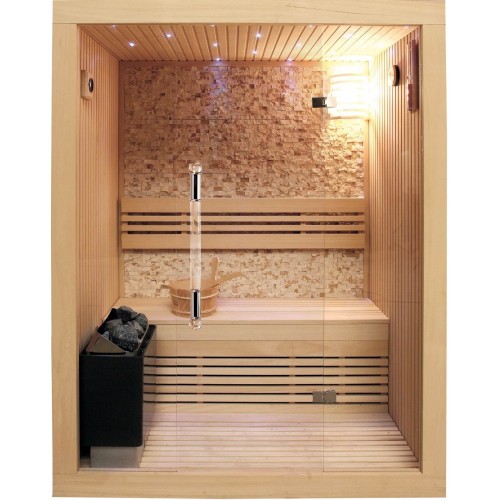Top Guidelines Of Traditional Sauna
Top Guidelines Of Traditional Sauna
Blog Article
Little Known Facts About Traditional Sauna.
Table of ContentsThe Ultimate Guide To Traditional SaunaThe 15-Second Trick For Traditional SaunaTraditional Sauna - An OverviewTraditional Sauna Things To Know Before You Get This
Many of the weight lost in a sauna is water loss and is re-gained upon rehydrating. Without an uncertainty sauna can be an important component of a healthy and balanced weight loss program. To take a look at the distinctions in between traditional and IR saunas, I will separate these into proven, academic, and produced differences.Hence, the best factor in the saunawhich is at the ceiling directly over the sauna heateris usually in between 185 and 190 F. Traditional Sauna. Claims that a standard sauna surpasses 200 F is simply not true and not applicable for electric saunas offered in the US. The temperature for a far-infrared sauna is normally established between 120 and 140 F; however, unlike the traditional sauna, the objective in and IR space is not to attain a heat
As a result of this, the temperature distinction is practically irrelevant, considering that extreme sweating leads to both sauna kinds, but the method of heating the body is various. In an IR sauna the bather will feel hot and will certainly sweat a lot, yet at a lot lower temperature levels. Therefore, if the objective is to spend longer amount of times in the sauna, the IR sauna is a great choice.

Facts About Traditional Sauna Revealed
When the high temperature level is accomplished, the components cycle on and off to preserve the heat. A lot of standard sauna users appreciate putting water over the rocks to create heavy steam to raise sauna moisture degrees. The advantages of pouring water over the rocks consist of: making the area more comfortable, moistening the nasal flows, and allowing the use of aromatherapy by mixing crucial oils with the water.
In a far-infrared sauna, the warm waves permeate the body to efficiently heat the body and elevate the body core temperature. To achieve this raised temperature, Far-infrared emitters create infrared power which is close to the same wavelength as that which the body naturally emitsoften described as the "Vital Variety" website link of 7 to 14 microns), so the power is well obtained by the body.
When the energy enters the body, it creates the body temperature to raise and inevitably leads to sweating. In an infrared sauna it is very important for the emitters/heaters to continue to be on virtually continuously. Given that there is no mass of rocks to preserve heat, the sauna will certainly cool if the emitters closed off.
As discussed above, the sauna bather in an infrared room wishes to place himself in front of operating emitters to obtain maximum advantage from the heat. The home heating time for both rooms can be extremely various, depending upon how the areas are used. For a traditional sauna, a bather ought to enable 30-40 mins for the space to accomplish a wanted temperature level and to effectively pre-heat the rocks.
9 Simple Techniques For Traditional Sauna
A well constructed sauna will typically accomplish a temperature of 150-160 F in concerning 30-40 minutes. For hotter temperatures, the space may require to warm for a longer period.
To some, 15 minutes was "lost" while the infrared energy warmed the wood panels instead of heating a body, while others locate a pre-heated room to be extra comfortable and think an click here for more elevated starting temperature is essential to start perspiring. The length of advised usage for every area is about the exact same (10-15 minutes per session); nevertheless, because of the reduced air temperature levels and the capacity to really feel the results of infrared heat much faster than a typical sauna, it is not uncommon for a person to spend a total of 20-30 minutes in an infrared sauna.
Typical saunas often tend to be bigger (therefore utilize more electricity) than infrared saunas, although typical saunas are absolutely readily available in one and 2 person dimensions also. For a two-person conventional sauna, 5x6 or 5x7 size is most prominent. The top bench can comfortably seat 2 or 3 people and is additionally enough time to rest throughout the sauna session.


The ordinary cost per kWH of power in the U.S. is about $0.11, so a 4.5 kW heating system will set you back about $.50 to compete one hour, if the heating unit runs continually for one hour. Commonly a sauna heating unit will run for 75% of the first hour and 50% of Discover More Here subsequent hours on since the aspects cycle once the set temperature level is achieved.
The Ultimate Guide To Traditional Sauna
A 2 person far-infrared space is normally physically smaller than a traditional sauna, frequently concerning 4' x 4' or smaller. The IR furnace is typically 1.5-1.7 kW utilizing a 120 volt 15 amp plug-in service. Given that the area can be used quicker than a sauna area, we will think the space is utilized for to of an hour consisting of heat up time.
There is a rarely talked about difference in the social experience between the two areas. While our culture has shed some of the social advantage of the typical sauna experience, it can be very socially gratifying. From family time in the sauna, to heart-felt discussions with substantial others, to sauna partiesthe standard sauna experience can result in intimate mingling.
Many greater end infrared spaces consist of tinted light therapy, sound systems and full-glass fronts.
Report this page